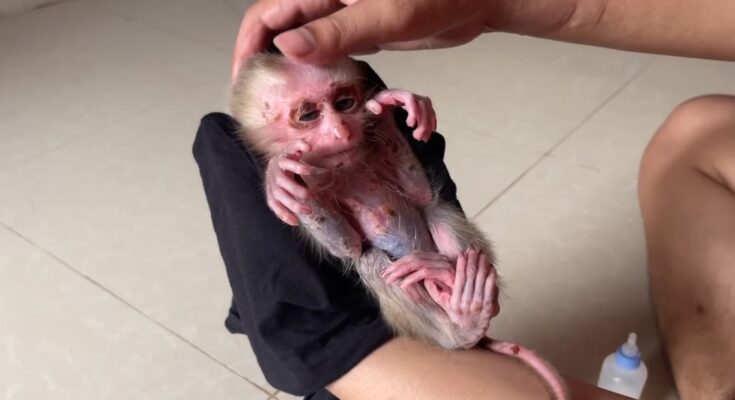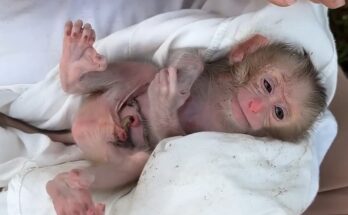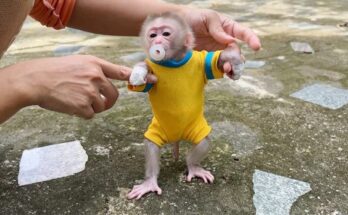Today, something deeply heartbreaking happened.
A tiny baby monkey was seen wandering the streets—alone, scared, and clearly homeless. Its eyes were full of confusion and fear. There was no mother in sight, no family, no one to offer comfort or protection. Just a helpless little creature trying to survive in a world far too big and cruel for someone so small.
People passed by. Some looked. Few cared. It was as if this baby didn’t matter. Its thin frame and trembling body told a story of days without food, nights without warmth, and a life without love.
But today, that story changed.
Someone saw not just a monkey—but a soul in pain. With compassion and care, the baby was gently picked up and taken to safety. Warmth replaced the cold. Food replaced hunger. And for the first time, this baby monkey felt safe.
It’s hard to believe how close it came to being forgotten forever.
Now, it has a second chance at life. A warm place to sleep, food to eat, and kind hands to hold it close. It may never understand how much it was once unloved—but it will always know what love feels like now.
How Monkeys Communicate: Understanding Their Language and Social Interactions
Monkeys are highly social animals that rely on complex communication methods to interact with their groups. From vocalizations to body language, they use a variety of signals to express emotions, warn of danger, and strengthen social bonds. In this article, we explore the fascinating ways monkeys communicate and what we can learn from them.
1. Vocal Communication: Calls and Sounds
Monkeys use an array of vocalizations to convey different messages. Some of the most common include:
- Alarm Calls: Many species, such as vervet monkeys, have specific alarm calls to warn against different predators like snakes, eagles, or leopards.
- Mating Calls: During mating season, some monkeys produce distinctive sounds to attract partners.
- Group Coordination Calls: Monkeys use sounds to maintain group cohesion, signaling movement or calling lost members back.
2. Facial Expressions and Body Language
Nonverbal communication plays a crucial role in monkey interactions. Some key examples include:
- Smiling or Baring Teeth: In many monkey species, showing teeth can be a sign of aggression rather than friendliness.
- Grooming: Grooming is a common behavior that strengthens social bonds and establishes trust among group members.
- Posture and Gestures: Dominant individuals may use upright postures to assert control, while submissive members show respect by lowering their heads or avoiding eye contact.
3. Scent Marking and Chemical Communication
Some monkey species use scent glands to mark their territory or signal reproductive status. For example, lemurs secrete scents from their glands to leave messages for others in their group.
4. Touch and Physical Contact
Touch is essential in reinforcing social connections. Monkeys frequently engage in grooming, hugging, and even playful wrestling to maintain strong social bonds within their troops.
5. Learning and Cultural Transmission
Monkeys can learn new communication methods through observation and imitation. Some primates, like capuchins, have even been observed developing unique signals and passing them down to younger generations, showcasing cultural transmission within groups.
Conclusion
Monkey communication is rich and complex, offering insights into the social structures and intelligence of these fascinating creatures. By studying how they interact, we can better understand not only their behavior but also the evolution of communication in primates, including humans.



